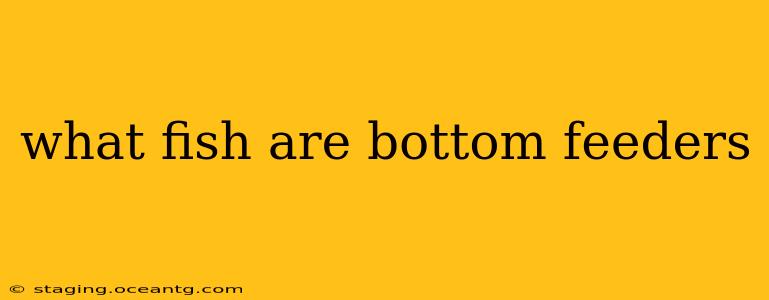What Fish Are Bottom Feeders? A Deep Dive into Benthic Biodiversity
Many fish species have adapted to thrive in the benthic zone, the lowest level of a body of water. These fish, known as bottom feeders, play a crucial role in maintaining the ecosystem's health. Understanding their feeding habits and the specific species involved is key to appreciating aquatic biodiversity. This article explores the fascinating world of bottom-feeding fish, answering common questions and offering insights into their ecological importance.
What types of fish are bottom feeders?
The term "bottom feeder" encompasses a wide variety of fish species with diverse adaptations for foraging on the seabed. They can be broadly categorized by their feeding strategies, although there is overlap:
-
Detritivores: These fish consume decaying organic matter, including dead plants, animals, and feces. This helps to keep the environment clean and recycle nutrients. Examples include many species of catfish, plecostomus (commonly known as suckerfish), and some loaches.
-
Substrate Feeders: These fish sift through the substrate (sand, gravel, mud) to find food particles. They often have specialized mouthparts adapted for this activity. Examples include some gobies, certain types of carp, and some types of ray.
-
Invertebrate Feeders: Many bottom feeders primarily target invertebrates like worms, crustaceans, mollusks, and insect larvae. These fish play a vital role in controlling invertebrate populations. Examples include many species of catfish, sculpins, and some eels.
What are some examples of bottom-feeding fish?
Let's explore some specific examples of bottom-feeding fish found in various aquatic environments:
-
Catfish: A diverse group, many catfish species are bottom feeders, using their barbels (whiskers) to locate food in murky waters. They consume a variety of organisms, including insects, crustaceans, and decaying matter.
-
Plecostomus (Suckerfish): These popular aquarium fish are known for their algae-eating habits, but they also consume detritus and other organic matter from the bottom.
-
Loaches: Many loach species are bottom dwellers, adept at navigating through gravel and sand to find food. They consume a mixture of algae, invertebrates, and organic debris.
-
Gobies: A large family of fish, many gobies are bottom dwellers, often found in shallow coastal waters. Their diets vary, but many are specialized invertebrate feeders.
-
Sculpins: These fish are often found in cold, rocky streams and rivers. They are generally carnivorous bottom feeders, preying on insects and other small invertebrates.
Are bottom feeders good for aquariums?
Whether or not a bottom-feeding fish is suitable for your aquarium depends on several factors, including tank size, other inhabitants, and the fish's specific needs. Some bottom feeders, like plecostomus, can help control algae growth, while others may require specific substrate types or diets. Researching the specific requirements of any bottom-feeding fish you consider adding to your tank is crucial to ensure its health and well-being.
What is the ecological role of bottom feeders?
Bottom feeders are essential components of aquatic ecosystems. Their feeding activities contribute to:
-
Nutrient cycling: They break down organic matter, releasing nutrients back into the water column for other organisms to utilize.
-
Water purification: Their consumption of decaying matter helps to maintain water quality.
-
Predator-prey relationships: They serve as a food source for larger fish and other predators.
-
Habitat maintenance: Their foraging activities can influence the structure and composition of benthic habitats.
Do all bottom-feeding fish eat the same thing?
No, bottom-feeding fish exhibit a wide range of dietary preferences. While some are primarily detritivores, others specialize in consuming specific invertebrates or algae. The specific diet of a bottom-feeding fish is influenced by its morphology (body shape and mouth structure), habitat, and the availability of food sources.
In conclusion, the world of bottom-feeding fish is diverse and fascinating. These creatures play critical roles in maintaining healthy aquatic environments and understanding their varied feeding habits offers valuable insights into the complex interplay of life within aquatic ecosystems.
